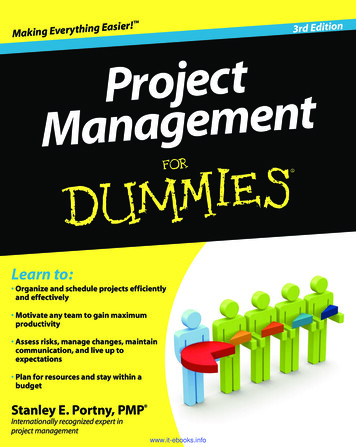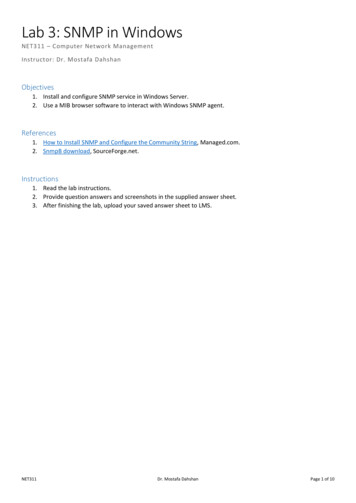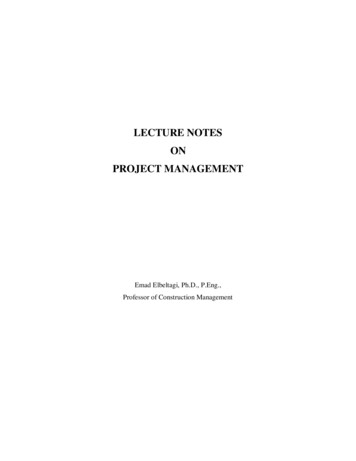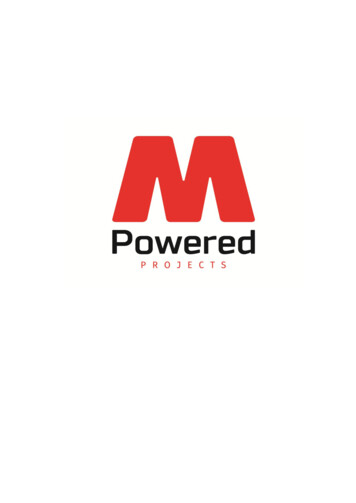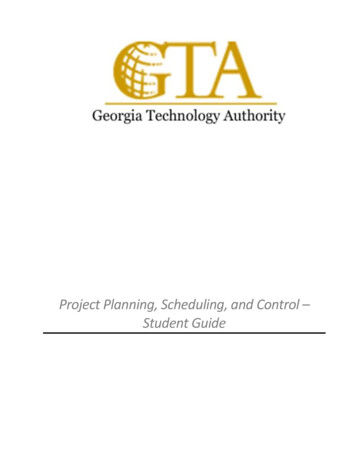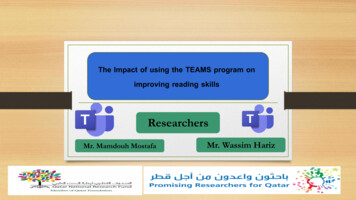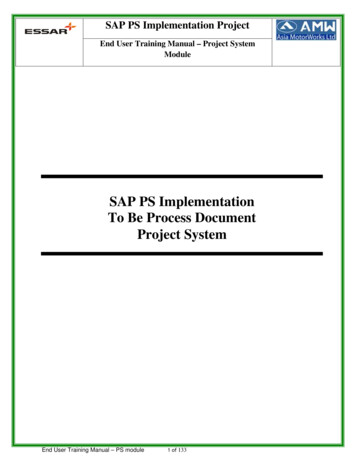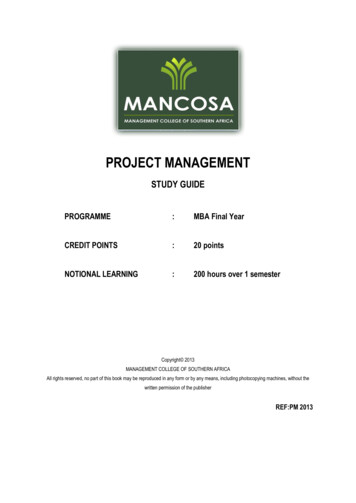
Transcription
PROJECT MANAGEMENTSTUDY GUIDEPROGRAMME:MBA Final YearCREDIT POINTS:20 pointsNOTIONAL LEARNING:200 hours over 1 semesterCopyright 2013MANAGEMENT COLLEGE OF SOUTHERN AFRICAAll rights reserved, no part of this book may be reproduced in any form or by any means, including photocopying machines, without thewritten permission of the publisherREF:PM 2013
Project ManagementMANCOSA – MBA Final Year2
Project ManagementAIMS OF THE MODULEThe broad aims of this module are to: Provide an overview of the concepts and techniques used in generic projectmanagement. Equip the learner with specific knowledge on effective management of theconstraints in project management, namely scope, cost, quality and time. Enable the learner to apply common techniques and tools used in projectmanagement to manage scope, time, cost and quality. Equip the learner with leadership skills to ensure proper management of humanresources in project management. Ensure learners are familiar with project resource management, including projectfinancial management. Provide knowledge on tools and techniques to ensure effective projectcommunication and risk management.MANCOSA – MBA Final Year3
Project ManagementOUTCOMES OF THE MODULEUpon completion of this programme, students should be able to: Understand and apply generic project management concepts and definitions. Understand the significance and impact of and relationship among the constraints in aproject environment. Demonstrate an understanding of the use of common tools and techniques used in thedifferent stages of a project life cycle. Effectively apply common project management tools and techniques, such as WorkBreakdown Structures, Gantt charts, Network diagrams and Critical Path Method, tomanage project scope and time. Demonstrate an understanding of potential project resource problems, and apply projecttools to alleviate these problems. Apply communication and risk management tools and techniques in a projectmanagement environment. Demonstrate an understanding of leadership expertise required to successfully manageand lead project teams, and to network with various project stakeholders. Understand project quality concepts, and apply tools used to monitor and improveproject quality at different stages of the project life cycle.Each section of the module has a more detailed list of outcomes.MANCOSA – MBA Final Year4
Project ManagementTABLE OF CONTENTSINTRODUCTION . 61. INTRODUCTION TO PROJECT MANAGEMENT . 102. PROJECT SCOPE, QUALITY, WORK BREAKDOWN STRUCTURE AND NETWORKDIAGRAM . 283. DEVELOPING THE PROJECT SCHEDULE . 464. PROJECT RESOURCE MANAGEMENT . 635. PROJECT COSTS, BUDGET AND EARNED VALUE. 8006. PROJECT COMMUNICATION AND DOCUMENTATION . 967. PROJECT RISK MANAGEMENT . 1098. PROJECT MANAGEMENT LEADERSHIP . 1219. PROJECT QUALITY MANAGEMENT . 14010. BIBLIOGRAPHY . 162MANCOSA – MBA Final Year5
Project ManagementINTRODUCTIONMANCOSA – MBA Final Year6
Project Management1. WelcomeWelcome to the Master of Business Administration Final Year Programme. As part of yourstudies, you are required to study and successfully complete this elective module on ProjectManagement.2. Context of the ModuleProject management is not uniquely confined to a specific context, and is a very adaptablefield that can be applied to the manufacturing and services sectors across various industries.This module uses a variety of references so that students are to able apply the principles andconcepts of project management to various manufacturing and production, scenarios at localand international facilities across most industries. The prescribed and recommendedtextbooks provide useful examples and some cases studies which enable one to apply theprinciples and concepts of project management in different contexts.3. How to use this ModuleThis module should be studied using this Study Guide and the prescribed textbook. Youshould read about the topic that you intend to study in the appropriate section of this StudyGuide before you start reading in detail in the prescribed and recommended textbooks.Ensure that you make your own notes/summaries as you work through the textbooks, otherlearning resources and this Study Guide.At the commencement of each section of this Study Guide, you will find a list oflearning outcomes. These learning outcomes outline the main points that you shouldunderstand when you have completed the section with its supporting chapters in theprescribed textbooks. Avoid reading all the material at once. Each study session should be nolonger than two hours without a break.As you work through the Study Guide you may come across: Think Points Activities Reading Activities Self Assessment Activities Study Group Discussion ActivitiesThese are designed to help you study and prepare for the assignment and examination.MANCOSA – MBA Final Year7
Project Management?THINK POINTA think point asks you to stop and think about an issue. Sometimes you are asked to apply aconcept to your own experience or to think of an example. ACTIVITYYou may come across activities which ask you to carry out specific tasks. The aim of theseactivities is to give you an opportunity to apply what you have learnt and / or explore an issuerelevant to the particular section. READING ACTIVITYSome sections of this Study Guide contain a reading activity. The reading activity requiresthat you read one or more of the recommended texts and then answer questions relevant tothat text / document. Some of the recommended texts are available from the Emerald libraryfacility and/or My Mancosa which learners may access via MANCOSA’s website. SELF ASSESSMENT ACTIVITYYou may come across self-assessment questions which will test your understanding of whatyou have learnt so far. You should refer to the Study Guide and prescribed textbooks whenattempting to answer the self-check activities.STUDY GROUP DISCUSSION ACTIVITYStudy group discussion activities may be provided at the end of each section ofthis Study Guide. You must have worked through the relevant section and supportingchapters in the prescribed textbooks prior to meeting as a study group. The study groupdiscussion activities provide an opportunity for learners to apply what they have learnt, toshare experiences with fellow learners and to learn from each other.MANCOSA – MBA Final Year8
Project Management4. Reading Prescribed TextbookSeveral recommended readings are provided in each section of the module guide. However,the textbook that has been prescribed for this module is:Clements, J. P. and Gido, J. (2011). Effective Project Management. 5th Edition.Boston: Cengage Learning. Recommended ReadingEach section has a list of recommended reading material, which will allow you to develop anunderstanding of the issues beyond the perspective of the prescribed textbook and StudyGuide. The following material is recommended in addition to the prescribed textbook:Burke, R. (2009). Project Management Techniques. College Edition. Hampshire:Burke Publishing.Burke, R.J. and Barron, S. (2007). Project Management Leadership. Hampshire:Burke Publishing.Heizer, J. and Render, B. (2010). “Project Management” (Ch. 3) in OperationsManagement. 10th Edition. New Jersey: Pearson Education Inc.PMI (2004). A Guide to the Project Management Body of Knowledge (PMBOKGuide). 3rd Edition. Pennsylvania: Project Management Institute.Schwalbe, K. (2009). Introduction to Project Management. 2nd Edition. Boston:Cengage Learning.5. Module Assessment Assignment: You will be required to complete and submit an assignment. This assignmentis assessed as part of your coursework. Therefore, it is very important that you complete it. Examination: A three-hour examination will be written at the end of the semester. Theassessment strategy will focus more on application of theory to practice.MANCOSA – MBA Final Year9
Project ManagementSECTION 11. INTRODUCTION TO PROJECTMANAGEMENTMANCOSA – MBA Final Year10
Project ManagementCONTENTSLearning outcomesReading Material1.1 Introduction1.2 Definition and attributes of a project1.3 Project constraints1.4 The project life cycle1.5 Summary of the project management process1.6 Reasons for successful project management1.7 ConclusionMANCOSA – MBA Final Year11
Project ManagementLearning Outcomes:The overall outcome for this section is that, on its completion, the learner should be able todemonstrate a basic understanding of the field of project management. This overall outcomewill be achieved through the learner’s mastery of the following specific outcomes, in that thelearner will be able to:1. Understand the definition and attributes of project management.2. Explain the project constraints and project environment model.3. Clearly explain the project life cycle in project management.4. Provide a summary of the project management process.5. Discuss the reasons for successful project management.MANCOSA – MBA Final Year12
Project ManagementReading Material: READINGPrescribed reading:Clements, J. P. and Gido, J. (2011). Effective Project Management. 5th Edition. Boston:Cengage Learning.Recommended reading:Heizer, J. and Render, B. (2010). “Project Management” (Ch. 3) in Operations Management.10th Edition. New Jersey: Pearson Education Inc.PMI (2004). A Guide to the Project Management Body of Knowledge (PMBOK Guide). 3rdEdition. Pennsylvania: Project Management Institute.Schwalbe, K. (2009). Introduction to Project Management. 2nd Edition. Boston: CengageLearning.Pycraft, M., Singh, H., Phihlela, K., Slack, N., Chambers, S. and Johnston, R. (2010). OperationsManagement. 2nd Edition. Cape Town: Pearson Education South Africa (Pty) Ltd.MANCOSA – MBA Final Year13
Project Management1.1 IntroductionProject Management is the application of knowledge, skills, tools and techniques to satisfystakeholder expectations from a project (PMBOK Guide, 2004). According to Pycraft et al.(2010:461), project planning and control is important because all managers will, at somepoint, get involved in managing projects. Project management is also an essential skill for allgeneral managers as new strategies can only be implemented through the careful selectionand implementation of projects (Pycraft et al., 2010:461). Due to time-based competition anda quality mandate in current business, the value of project management as a strategic asset isrealised. READING ACTIVITYRead the Case Study entitled “Feds and Contractor Share Blame for Afghan Plant Delays”(Chapter 1, page 2) in Clements and Gido (2011). Identify the major pitfalls of thecontractors and subcontractors involved in the project. What could have been done moreeffectively to avoid these problems?1.2 Definition and attributes of a projectClements and Gido (2011:4) define a project as an “endeavour to accomplish a specificobjective through a unique set of interrelated tasks and the effective utilisation of resources.”Heizer and Render (2010:90) define a project as “a series of related tasks directed toward amajor output.” A project is a temporary endeavour undertaken to create a unique product, serviceor result (PMBOK Guide, 2004). All projects have some elements in common and, accordingto Pycraft et al. (2010:464), these include: An objective. A definable end result, output or product, which is defined in terms ofcost, quality and timing.MANCOSA – MBA Final Year14
Project Management Complexity. Several tasks are required to be undertaken to achieve the objectives. Therelationship between all these tasks can be extremely complex. Uniqueness. A project is usually a one-off undertaking. Uncertainty. As all projects are planned before they are executed, they carry a certainamount of risk. Life cycle. Projects normally go through three phases – planning, execution andphase-out. Temporary nature. Resources may be moved from one project to the next once thetasks have been completed. READING ACTIVITYRead the section entitled “Project Attributes” on page 4 of Chapter 1 in Clements and Gido(2011) and briefly describe each of the following project attributes:1. Clear objective:2. Interdependent tasks:3. Resource utilisation:4. Specific time frame:5. Unique or one-time endeavour:6. Project sponsor or customer:7. Degree of uncertainty:MANCOSA – MBA Final Year15
Project Management1.3 Project constraintsLike any human undertaking, projects need to be performed and delivered under certainconstraints. Burke (2009:36) illustrates the relationship between time, cost and scope (the “tripleconstraint”), where a change in one parameter can affect the others (refer to Figure 1.1). This isaccompanied by quality, the organisation breakdown structure (OBS), and an awareness ofexternal issues in the environment. The time constraint refers to the amount of time available tocomplete a project. The cost constraint refers to the budgeted amount available for theproject. The scope constraint refers to what must be done to produce the project's end result.These three constraints are often competing constraints: increased scope typically meansincreased time and increased cost, a tight time constraint could mean increased costs andreduced scope, and a tight budget could mean increased time and reduced scope.Figure 1.1: The Project Environmental Model (Source: Burke, 2009:36).Clements and Gido (2011:6) also explain the project constraints consisting of scope, quality,schedule (time), budget, resources, risks and customer satisfaction. These constraints have tobe considered before and during the planning and execution of a project.MANCOSA – MBA Final Year16
Project Management1.4 The project life cycleProject management is achieved by applying and integrating project management processeswhich include: initiating, planning, executing, control and monitoring, and closing. These arereferred to as process groups and they dictate the life cycle of a project. Apart from processgroups there are knowledge areas, which are the backbone and knowledge base of projectmanagement. The knowledge areas consist of project integration, scope, time, cost, quality,human resources, communications, risk, and procurement management.The four generic phases of a project life cycle (Figure 1.2) are: initiating, planning,performing (executing) and closing the project (Clements and Gido, 2011:9).Figure 1.2: Project Life Cycle Effort (Adapted from Clements and Gido, 2011:9).Alternatively, Pycraft et al. (2010) state that the three stages of a project are planning,execution and phase-out. However, according the Heizer and Render (2010), projects aredivided into three phases, namely planning, scheduling and controlling.Planning:includes goal setting, defining the project and team organisation.Scheduling:relates people, money and supplies to specific activities and relates activities toeach other.Controlling: the firm monitors resources, costs, quality and budgets, and it also revises orchanges plans to meet time and cost demands (Heizer and Render, 2010:90).MANCOSA – MBA Final Year17
Project Management ACTIVITYYou have been tasked with the construction of a house. Using the project life cyclestages/phases, identify the activities that must be performed at each stage.1.4.1 Project initiationProjects are first selected based on the identification of a need, problem or opportunity. Asponsor of a project usually identifies these needs and provides the funds necessary for theproject. Apart from the sponsor, a range of project stakeholders must also be identified in thisphase of the project. The following is a list of typical stakeholders in a project: Project Sponsor – The person that provides the financial resources for the project. Project Manager – The single point responsibility of a project. PMO – The project management office provides support to the project. Customer or user – This is the person or entity that will use the project’s product. Project management team – the members of the project team who are directlyinvolved in executing the project management functions. Influencers – People or groups who are directly or indirectly interested or affected bythe project. They can also influence the project positively or negatively. Investors – A person or entity making the investment in a project. Contractor – A contractor is normally the person or organization that is entrusted withsupplying the services and/or goods to achieve project deliverables. Government – The government is in most cases a stakeholder in projects whether theyare public or private sector projects because it has an interest in the project, e.g.collecting taxes.MANCOSA – MBA Final Year18
Project Management1.4.1.1 Project SelectionClements and Gido (2011:33) explain the following four steps in the selection of a project:i.Develop a set of criteria against which the project will be evaluated. This must takeinto account, inter alia, the company goals, sales volume and market share,investment, risks, resources, competitors, regulations, etc.ii.List the assumptions that will be used as the basis for each project.iii.Gather data and information for each project.iv.Evaluate each project against the identified criteria.According to Schwalbe (2009), project selection may take place using one or more of thefollowing methods: Focus on strategy and organisational needs Performing a financial model Using weighted scoring model Implementing a balanced scorecard Addressing problems, opportunities and directives Considering project time frames, and Considering project priorities.1.4.1.2 Project CharterOnce a project is selected, it is formally authorised and primed using a project charter(Clements and Gido, 2011). The project charter includes the rationale or justification for theproject and is usually the first official document that initiates a project. ACTIVITYUsing the prescribed and recommended texts, identify the contents of a project charter anddraft such a document for a project of your choice. Hint: Refer to Chapter 2 of Clements andGido (2011:36-40) or Schwalbe (2009:90).MANCOSA – MBA Final Year19
Project ManagementThe typical contents of a project charter are: Project title and date of authorisation Background to the project Key assumptions Business needs and other commercial needs Scope of work Key milestones Project scheduling including estimated start and finish dates Project estimated budget Approach Roles and responsibilities of project team and project organisation.1.4.1.3 Project Request for ProposalA project that is outsourced requires the preparation of a Request for Proposal (RFP)document, the contents of which are outlined below (Clements and Gido, 2011): Project objective Statement of Work (SOW) Customer requirements Deliverables Acceptance criteria Customer-supplied items Approvals required by the customer Type of contract the customer intends to use Payment terms Required schedule for completion of the project and key milestones Instructions for the format and content of the contractor proposals Due date for proposals Evaluation criteria Funds that may be available for the project1.4.1.4 Project Statement of WorkSchwalbe (2009) illustrate a typical Statement of Work (Figure 1.3) which also includeselements of a comprehensive RFP.MANCOSA – MBA Final Year20
Project ManagementFigure 1.3: Statement of Work with elements of a comprehensive RFP (Source:Schwalbe, 2009).MANCOSA – MBA Final Year21
Project Management1.4.2 Project planningThe purposes of project planning are as follows: It determines the cost and duration of the project. It determines the level of resources that will be needed. It helps to allocate work and to monitor progress (who is responsible for what). It helps to assess the impact of any changes to the project (Pycraft et al., 2010).Planning the project involves determining what needs to be done (scope, deliverables), how itwill get done (sequence of activities), who will perform it (human resources), how long it willtake (schedule), how much it will cost (budget) and what the risks are (Clements and Gido,2011). These important considerations are generally included in a comprehensive projectproposal (Refer to Chapter 3 of Clements ad Gido, 2011).Planning may have to be carried out more than once during a project, due to changingcircumstances and demands. The result of the planning process is a baseline plan (Clementsand Gido, 2011:19). The basic stages in the planning process are illustrated in Figure 1.4.Figure 1.4: Stages in the project planning process (Source: Pycraft et al., 2010:472).Preparing a project proposal is often a task that managers are presented with when they haveidentified a project that will enable them to solve a problem or fulfil a business opportunity.The essential elements of a project proposal are: Statement of customer’s need or problem AssumptionsMANCOSA – MBA Final Year22
Project Management Project scope Deliverables Resources Schedule of the project Price considerations Risks Expected benefits?THINK POINTSuppose you were the sponsor of a large project involving the construction of a hotel. Whatwould be some of the critical success factors you would assess in the project proposal handedover to you for evaluation and approval?1.4.3 Project execution (performing)After planning the project, the third phase involves the accomplishment of the projectobjective(s) (Clements and Gido, 2011). The executing process group consists of the processesused to complete the work defined in the project management plan to accomplish the project’srequirements. The project team should determine which of the processes are required for theteam’s specific project. This process group involves coordinating people and resources as well asintegrating and performing the activities of the project in accordance with the projectmanagement plan.Project execution entails fulfilling the deliverables of the project within the client’s acceptedspecifications and budget and time constraints. The function that matters most during thisphase is the monitoring and control of progress to ensure that everything is going accordingto plan.MANCOSA – MBA Final Year23
Project ManagementKey outputs of the executing process relating to the project integration management include:project deliverables, requested changes, implemented change requests, implemented correctiveactions, implemented preventive actions, and implemented defect repair. Executing outputsrelating to project quality management include: requested changes, recommended correctiveactions, organizational process assets update, and updated project management plans. Executingoutputs relating to project human resources management knowledge area include: project staffassignments, resource availability, updated staffing management plan and, team performanceassessment.During this phase, monitoring and controlling project work involves collecting, measuring, anddisseminating performance information as well as assessing measurements and analyzing trendsto determine what process improvements can be made. On the other hand, performing integratedchange control involves identifying, evaluating, and managing changes throughout the project’slife cycle. Every project will experience changes at one point or another. It is therefore importantto develop a process of monitoring controlling and documenting project changes.1.4.4 Project closureThe closing process group is the most neglected project phase of all the phases in a project. Thisphase includes processes used to formally terminate all the activities of the project or phase. Theproject success or failure is evaluated and the project is handed over to the client. The projectexperiences or lessons learnt are documented. Closing projects involves stakeholder and customeracceptance of the final product or service, and bringing the project to an orderly end.1.5 Summary of the project management processAccording to Clements and Gido (2011), the project management process comprises thefollowing steps:i.Establish project objective.ii.Define the scope.iii.Create a work breakdown structure (WBS) by subdividing the scope into pieces or workpackages.iv.Assign responsibilities.v.Define specific activities.vi.Sequence the activities using a network diagram.MANCOSA – MBA Final Year24
Project Managementvii.Estimate activity resources.viii.Estimate activity durations.ix.Develop a project schedule.x.Estimate activity costs.xi.Determine the budget.1.6 Reasons for successful project managementPycraft et al. (2010:466) outline the following factors that can contribute to the success of aproject: Clearly defined goals. This should include the general project philosophy or generalmission of the project and a commitment to those goals on the part of the project teammembers. Competent project manager. A skilled leader who has the technical, interpersonal andadministrative skills. Top-management support. Senior management commitment to the project must beopenly displayed and communicated to all stakeholders. Competent project team members. Careful selection of team members is vital.Choose a ‘winning’ team. Sufficient resource allocation. Money, labour, machines, materials and otherbusiness related items must be available in the required quantities. Adequate communication channels. Up-to-date information must be available to theproject team on a continual basis. Communication channels to the various role playersmust be established. Control mechanisms. A system to monitor actual events against planned outcomesmust be set up. Feedback capabilities. All parties that are involved in the project must be able toreview the project status on a regular basis and make suggestions and correctionsthrough formal feedback channels or review meetings. Responsiveness to clients. All stakeholders must be kept informed regularly on theprojects status.MANCOSA – MBA Final Year25
Project Management Trouble-shooting mechanisms. Set up a system or a set of procedures to tackleproblems when they arise and the ability to trace back to the root cause of theproblem. Project staff continuity. Key project personnel must be kept on for the duration of theproject. Frequent staff turnover results in the project losing the wealth of knowledge,which may have been accumulated.1.7 ConclusionGeneral managers often work closely with project managers in various projects within orsometimes outside the organisation, and are therefore required to have an understanding ofproject management and the techniques used in project planning and scheduling. Effectiveproject management also allows firms to create products and services for global markets.However, project management techniques do not solve all project scheduling andmanagement problems, and for this, good management practices, clear responsibilities fortasks, timely reporting systems and contingency plans are necessary.The next section will deal with project scope and time management.MANCOSA – MBA Final Year26
Project Management SELF ASSESSMENT ACTIVITY 1Consider a project in which you are currently involved (or which you may be familiar with).a) Describe the objectives, scope, schedule, cost and any assumptions made.b) Where is the project in its life cycle?c) Does the project have a baseline plan? If yes, describe it. If not, create it.d) Are you or is anyone else monitoring the progress of the project? If so, how? If not, howcould you do so?e) Describe some unexpected circumstances that could jeopardize the success of the project.f) Describe the anticipated benefits of the project. SELF ASSESSMENT ACTIVITY 2Develop an RFP for a real-world project such as landscaping the grounds surrounding anearby business office, building a deck for your house, or holding a big graduationcelebration. Be creative in specifying your needs.MANCOSA – MBA Final Year27
Project ManagementSECTION 22. PROJECT SCOPE, QUALITY, WORKBREAKDOWN STRUCTURE AND NETWORKDIAGRAMMANCOSA – MBA Final Year28
Project ManagementCONTENTSLearning outcomesReading Material2.1 Introduction2.2 Establishing the project objective2.3 Defining the scope of the project2.4 Planning for quality2.5 Creating a Work Breakdown Structure2.6 Defining activities2.7 Activity sequence and network diagrams2.8 ConclusionMANCOSA – MBA Final Year29
Project ManagementLearning Outcomes:The overall outcome for this section is that, on its completion, the learner should be able todemonstrate an understanding of project scope, quality, responsibility and activity sequence.This overall outcome will be achieved through the learner’s mastery of the following specificoutcomes, in that the learner will be able to:1. Identify and describe the knowledge areas of project management.2. Develop project objectives.3. Define the scope of a project using tools such as the scope management plan,scope statement (scope document), Work Breakdown Structure (WBS), and WBSdictionary.4. Explain in the detail the meaning and implications of scope creep.5. Plan for quality and describe the costs of quality.6. Create a Work Breakdown Structure and describe different approaches to do so.7. Apply activity sequencing and create net
Effective Project Management. 5th Edition. Boston: Cengage Learning. Recommended Reading Each section has a list of recommended reading material, which will allow you to develop an understanding of the issues beyond the perspective of the prescribed textbook and Study Guide. The



